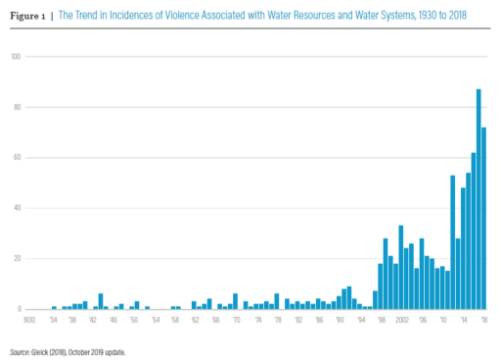By Peter H. Gleick
Growing Tensions Over Freshwater
In recent years, a wide range of water-related factors have contributed to political instability, human dislocation and migration, agricultural and food insecurity, and in more and more cases, actual conflict and violence. Demand for water has grown as populations and economies expand, while the availability and quality of the planet’s freshwater resources are increasingly influenced by industrial and human water pollutants, and increasingly by human-caused climate change. Water problems do not necessarily lead to conflict — in fact, violence associated with water systems and problems is the exception, not the rule. However, data collected by the Pacific Institute in the Water Conflict Chronology show that water-related violence is increasing (Figure 1).

Strategies for Reducing Water-Related Conflicts
Although water risks are worsening worldwide, there are many strategies to reduce water conflicts and improve water security. A comprehensive new assessment of these strategies was released in September 2020 by the Pacific Institute, the World Resources Institute, and the Water, Peace, and Security Partnership. Solutions to water and security challenges can be described and categorized in many ways. The report offers four broad categories:
- Natural resources, science, and engineering approaches;
- Political and legal tools;
- Economic and financial tools; and
- Policy and governance strategies.
“Although water risks are worsening worldwide, there are many strategies to reduce water conflicts and improve water security.”
From Strategy to Action: Reducing Water-Related Conflict Around the Globe
The report focuses on identifying and understanding these strategies, where they might be most effectively applied, and how to overcome barriers to implementing them. It also provides six detailed regional or country case studies on how different combinations of these solutions — if successfully implemented — could help to mitigate the risk of water-related instability. The cases studies include Iraq, Iran, India, The African Sahel, the Central American Dry Corridor, and Yemen.
The cases were chosen where severe water and security challenges are already evident and illustrative of a broad spectrum of problems. Each of the case studies begins with a description of the factors that are driving these water-related challenges and a summary of the conflict or crisis itself. Each case study then describes possible solutions to address the specific drivers of the water-related challenges. Importantly, this discussion of solutions includes examples of the solutions being put into practice.
In Iraq, for example, exceedingly poor water quality in southern Iraq triggered violent demonstrations against the government. At the same time, reductions in flows in the Tigris and Euphrates rivers due to upstream interference from Turkey and Syria and accelerating climate change are contributing to tensions over both water quantity and quality.
In Iran, overuse of water relative to available supply has led to internal tensions and violent confrontations over access to water. Iran also has ongoing disputes with neighboring countries over use of water in its shared river basins.
In the African Sahelian region, increasing scarcity of water and land resources has led to a major increase in violence between local farmers and pastoralists, and contributed to worsening religious tensions among different groups. Expansion of settled communities has contributed o appropriation of watering holes and closure of lands formerly open to nomadic groups.
Existing Challenges and Recommendations
The report concludes with seven major conclusions and recommendations:
- More and more countries are confronting water insecurity as water demands increase and water supplies decrease, become contaminated, or are affected by extreme events.
- While solutions exist on paper, they are often difficult to apply politically. As challenges to social stability grow, all parties need to mobilize the political will and economic and technical capacity to effectively address them.
- Among the first things needed to confront these challenges are data and information systems that can help monitor conditions and provide early warning of potential problems.
- Once high-risk areas are identified, the international community should have rapid response teams that can assist at-risk countries
- Most solutions require significant funding. The rapid response teams should therefore have the backing of development banks, bilateral aid agencies, the private sector, and other funders that can furnish needed grants or loans. Funds should be set aside by these organizations specifically to address emerging water and security crises.
- The challenge of collective action is significant, but it can be overcome if and when societies recognize the benefits of needed changes and the perils of continuing with “business as usual.”
- Understanding pathways, timelines, and the complex interaction of multiple factors at work in a crisis is vital to help policymakers design effective policy responses.
Further Resources on Water-Related Conflict
Report: Ending Conflicts Over Water: Solutions to Water and Security Challenges Video: Ending Conflicts Over Water Tool: Water Conflict Chronology Tool: WPS Global Early Warning Tool


